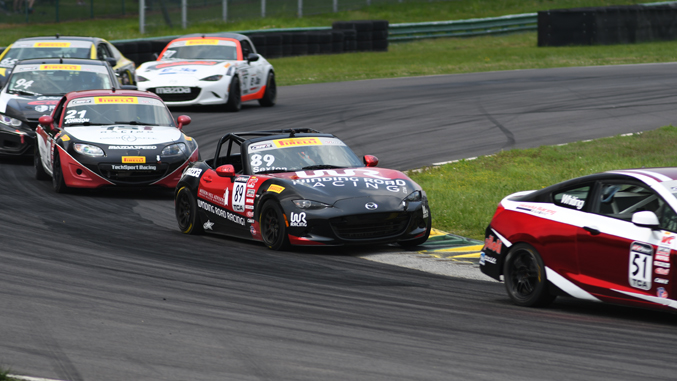Winning The Battle, Losing The War

Since we are at the track most weekends running cars in Pirelli World Challenge, MX-5 Cup, SCCA and NASA events, we see a lot of racing up close. We're generally not watching the overall race, but are working with specific drivers to help them succeed. So we see things, especially in the middle of the pack, that never make it to TV.
From that, we'd say most racers would do well to contemplate their approach to "the race within the race". What we mean is that many racers, after the chaos of the start, find themselves by lap 2 or 3 in a group. Very often, group 1 (the front runners) will be 2-4 cars, then there will be a gap to group 2, with 3-6 cars, etc. The "race within a race" is the approach drivers take to working with or racing against their local group.
90% of the time, the drivers in group 2 and group 3 begin to have tactical battles with each other right away (from lap 2 on). This succeeds in slowing the whole local group down, often guaranteeing that, say, group 2 drivers cannot be on podium. Why? Because the front runners don't do this (as much) and they run better average lap times. We recently watched a race where the front 2 and cars 3-6 ran essentially the same fast laps, but group 2 lost almost a second per lap to the front because of ongoing tactical battles.
If you're in group 2 and you assume that 4th is pretty good result, so you take what you can get, then maybe this is rational. But we observe that the drivers who consistently finish higher don't think like this.
First off, they assume that passing opportunities are closer to random than indicators of absolute pace. That means if you force a pass, you'll probably just get re-passed a lap or two later. So they want to defer passing until later in the race when they think they can make it stick.

Second, the front runners want to do everything they can to gap the field. They know that tactical battles keep group 2 cars closer.
Third, the front runners will make tactical passes, but generally when the pass can be made cleanly, without slowing the group down. This can mean sitting in P2 or P3 for five or ten laps.
Drivers farther back almost never have this kind of patience. The particularly egregious behavior often comes from the back of group 2. For example, the driver running 7th is constantly trying to force the driver in 6th to give up the spot. This approach often succeeds in splitting group 2 in half and almost guarantees that these drivers can get 6th at best.
There isn't a huge amount you can do about this, but we suggest three things. If you can hold off on passing the driver in front of you early in a race, you have the (small) chance to build trust. You can also practice your passing skills, so that you have more confidence that you can pull off passes when you need to, rather than being relentlessly opportunistic. Finally, when a driver does set up a pass on you in the first 75% of the race, see if you can set up the driver to make the pass smoothly so that neither of you lose much time.


















